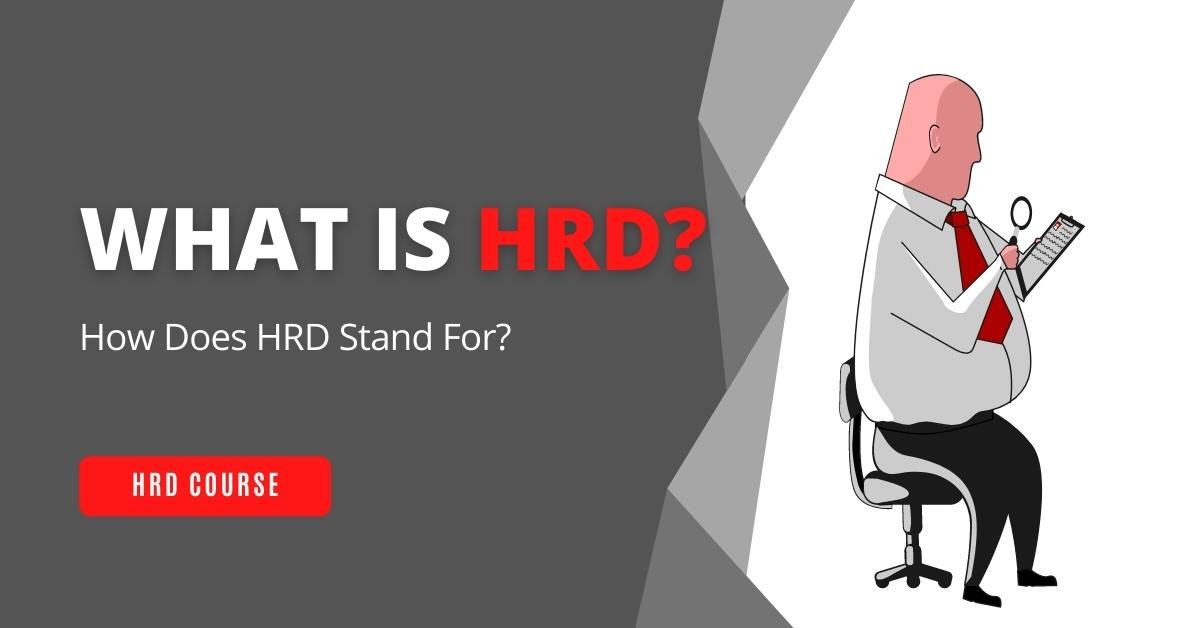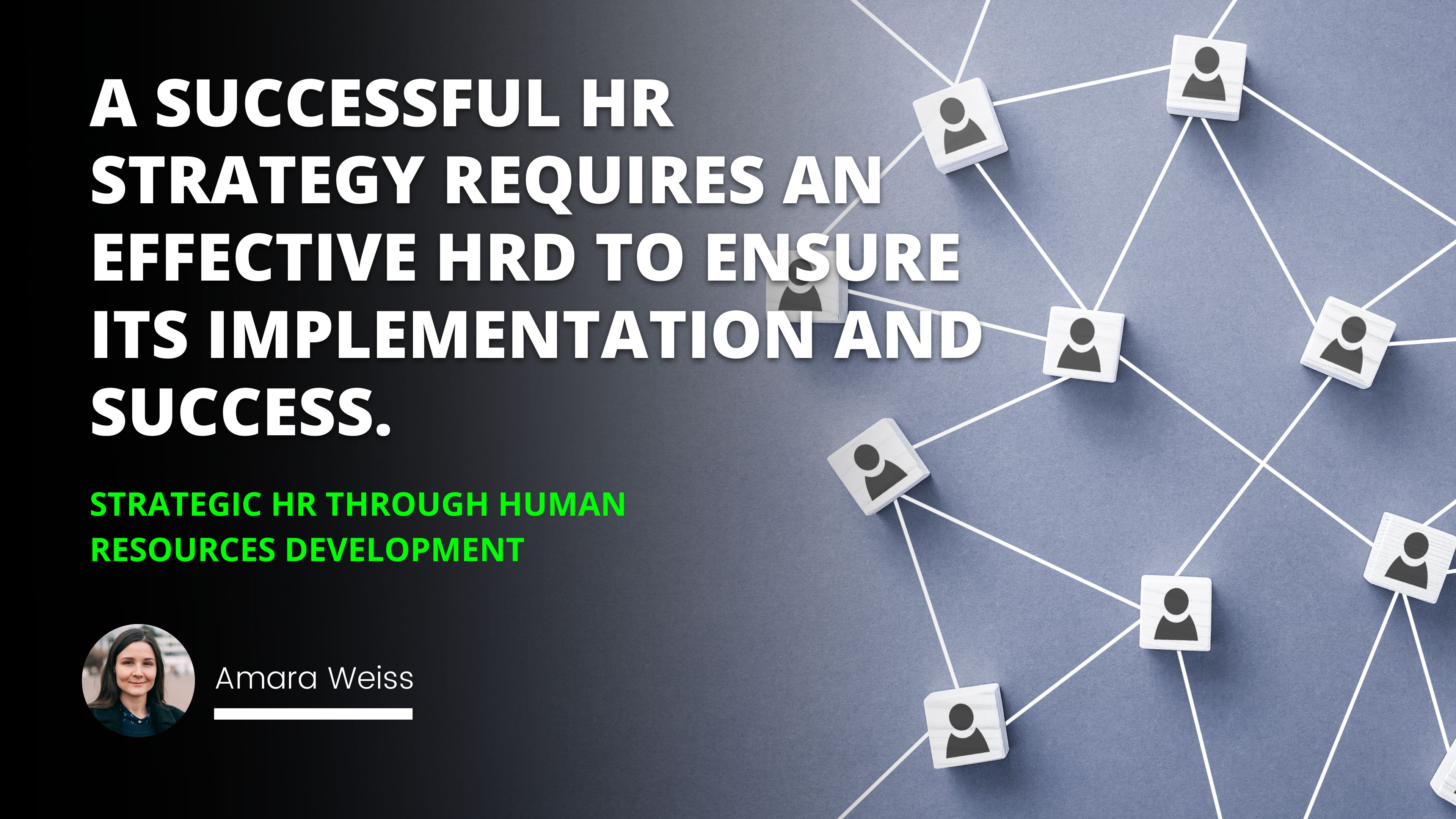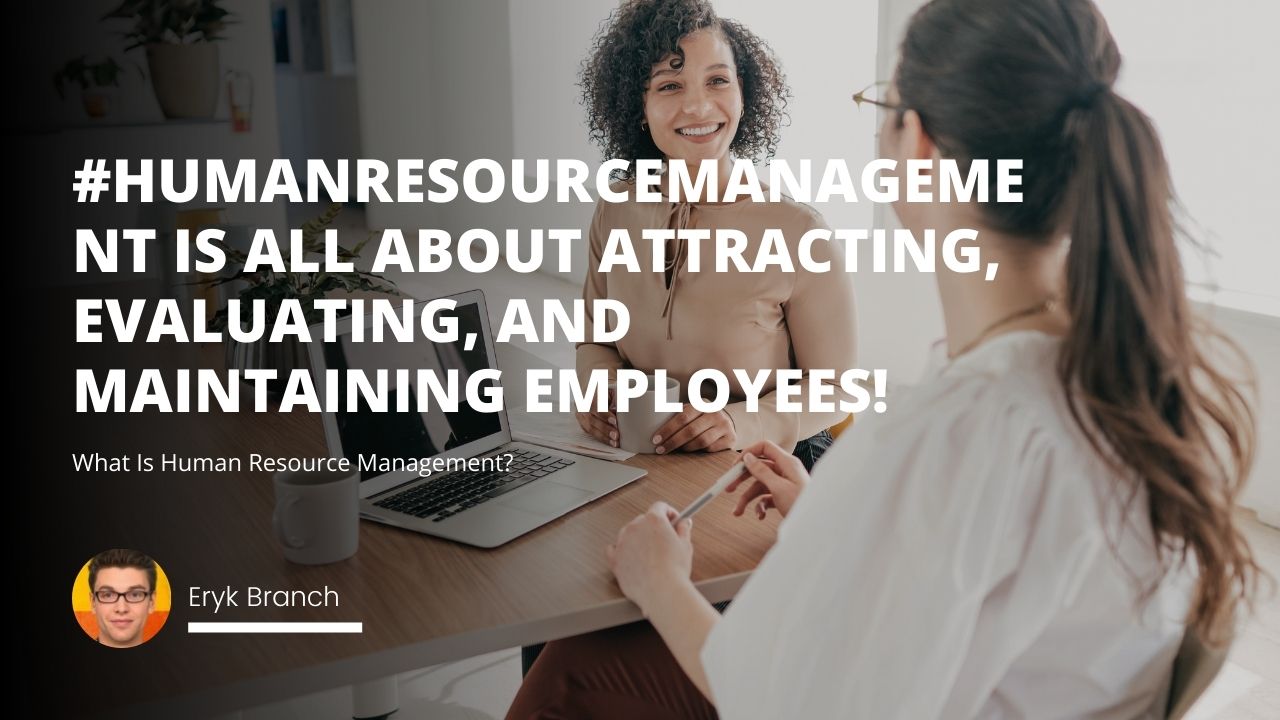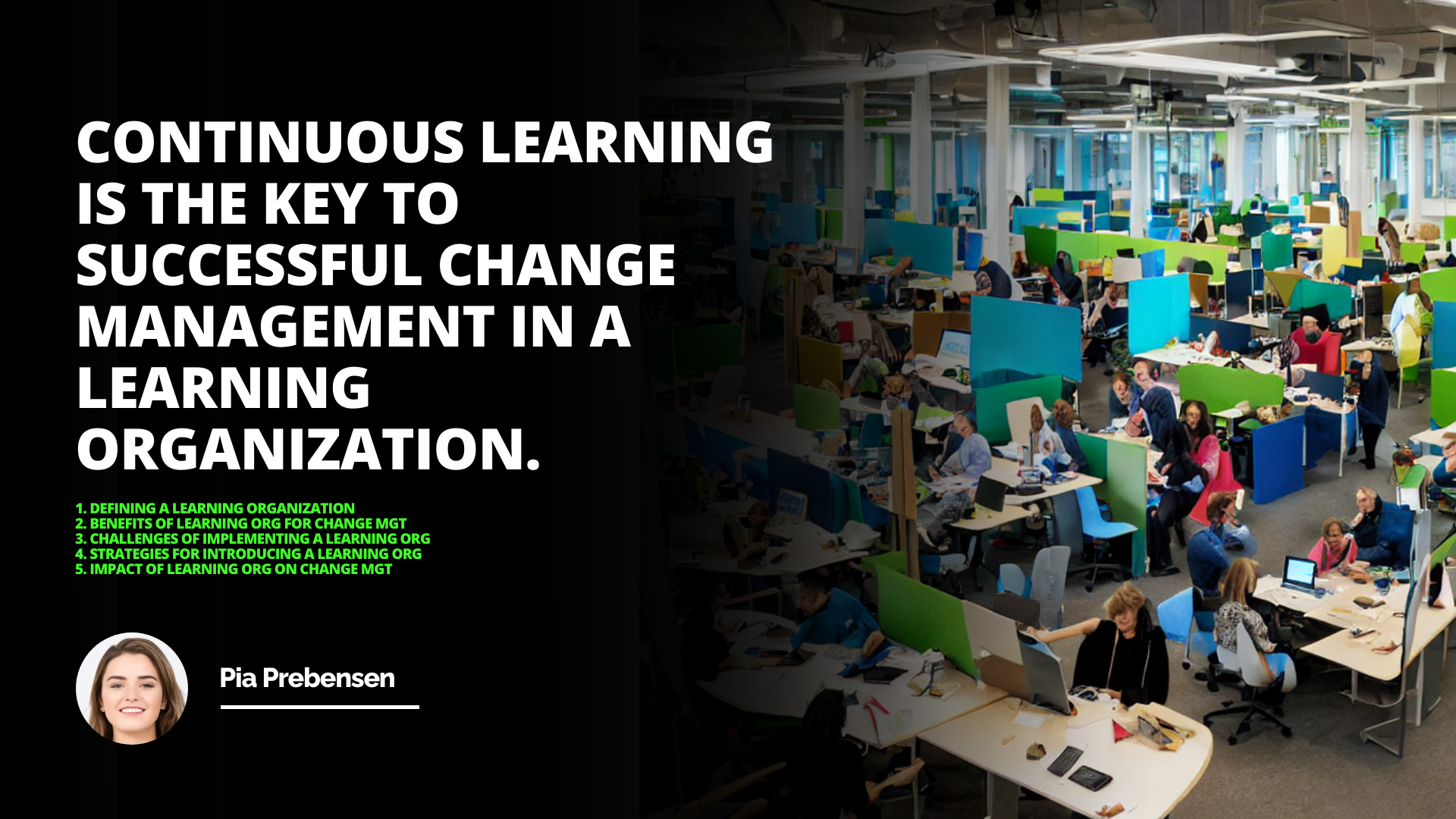
As I sat in the crowded café, sipping my latte and gazing out the window at the bustling street, I couldn't help but reflect on how much the world around us is changing. Businesses rise and fall, technologies evolve at lightning speed, and the way we work continuously transforms. In this ever-shifting landscape, one thing has become abundantly clear to me: organizations that prioritize learning and adaptability not only survive but thrive. This realization brings me to the concept of a learning organization, a term that might sound academic but holds profound practical importance.
Definition of a Learning Organization
Benefits of a Learning Organization for Change Management
Challenges of Implementing a Learning Organization
Strategies for Introducing a Learning Organization
Impact of a Learning Organization on Change Management
Understanding the Essence of a Learning Organization
So, what exactly is a learning organization? At its core, a learning organization is one that embraces continual learning as a fundamental component of its culture. Rather than sticking rigidly to old methods, it encourages employees at all levels to recognize issues and experiment with new solutions. It's an environment where knowledge-sharing isn't just a buzzword but a daily practice, and where collaboration leads to innovative problem-solving.
I recall a time when I was working with a small tech startup. We were navigating the challenges of entering a saturated market, and success seemed elusive. One day, during a team meeting, our manager proposed a radical idea: let's encourage everyone, from interns to executives, to bring forward any insights or ideas they had, no matter how unconventional. Initially, I was skeptical. But as we started sharing and collaborating more openly, the collective intelligence of our team skyrocketed. We began to spot opportunities that were previously invisible to us, leading to the development of a unique product feature that set us apart from competitors.
This experience underscored for me how a flexible and adaptive culture, one that emphasizes learning and change, can be a game-changer. It's not just about acquiring new knowledge but about fostering an environment where continuous improvement is ingrained in the organizational DNA.
The Benefits of a Learning Organization for Change Management
Implementing change within any organization can be a daunting task. People are naturally resistant to change, especially if they don't understand the reasons behind it or how it will affect them. This is where a learning organization shines. In such an environment, employees are more likely to embrace change because they are equipped with the necessary knowledge, skills, and support to navigate transitions.
Think about it: when employees are actively involved in learning and development, they become more adaptable and open-minded. They are better prepared to handle new challenges and less likely to fear the unknown. Moreover, a learning organization fosters excellent communication and collaboration, which can significantly reduce resistance to change. When people feel heard and involved in the process, they are more invested in the outcomes.
During my time working with a multinational corporation, we underwent a major structural reorganization. Initially, there was widespread anxiety among staff. However, the company's commitment to learning meant that they provided extensive training sessions, Q&A forums, and support groups. We were encouraged to share our concerns openly and collaborate on finding solutions. This approach helped ease the transition and even sparked innovative ideas on how to improve workflows.
Furthermore, learning organizations are better equipped to identify opportunities for improvement and innovation. They are proactive rather than reactive, constantly scanning the environment for trends and potential disruptions. This foresight helps ensure that changes are well-informed and practical, aligning with the organization's strategic goals.
Establish a Clear Vision: A clear vision of the desired state of the learning organization should be established. It should be communicated to all members of the organization in order to create a shared understanding.
Foster Collaboration: Collaborative working environment should be fostered in order to promote knowledge sharing and learning. It is essential for employees to feel comfortable working together and contributing ideas.
Open Communication: Communication should be open and honest. This allows for the free exchange of information, ideas, and opinions. It also encourages feedback and suggestions from employees.
Encourage Learning: The organization should provide learning opportunities for employees. This could include training programs, workshops, seminars, and other activities that promote learning.
Reward Learning: Rewards should be implemented to motivate employees to learn. This could include recognition, financial rewards, or other incentives.
Promote Creativity: The organization should promote creativity and innovation. This encourages employees to think outside the box and develop new ideas.
Measure Performance: The organization should measure the performance of its employees. This allows for evaluating their progress and helps identify areas for improvement.
Implement Change: Change should be implemented gradually. This ensures that employees are calm and can adjust to the new environment.
Continuous learning is the key to successful change management in a learning organization.
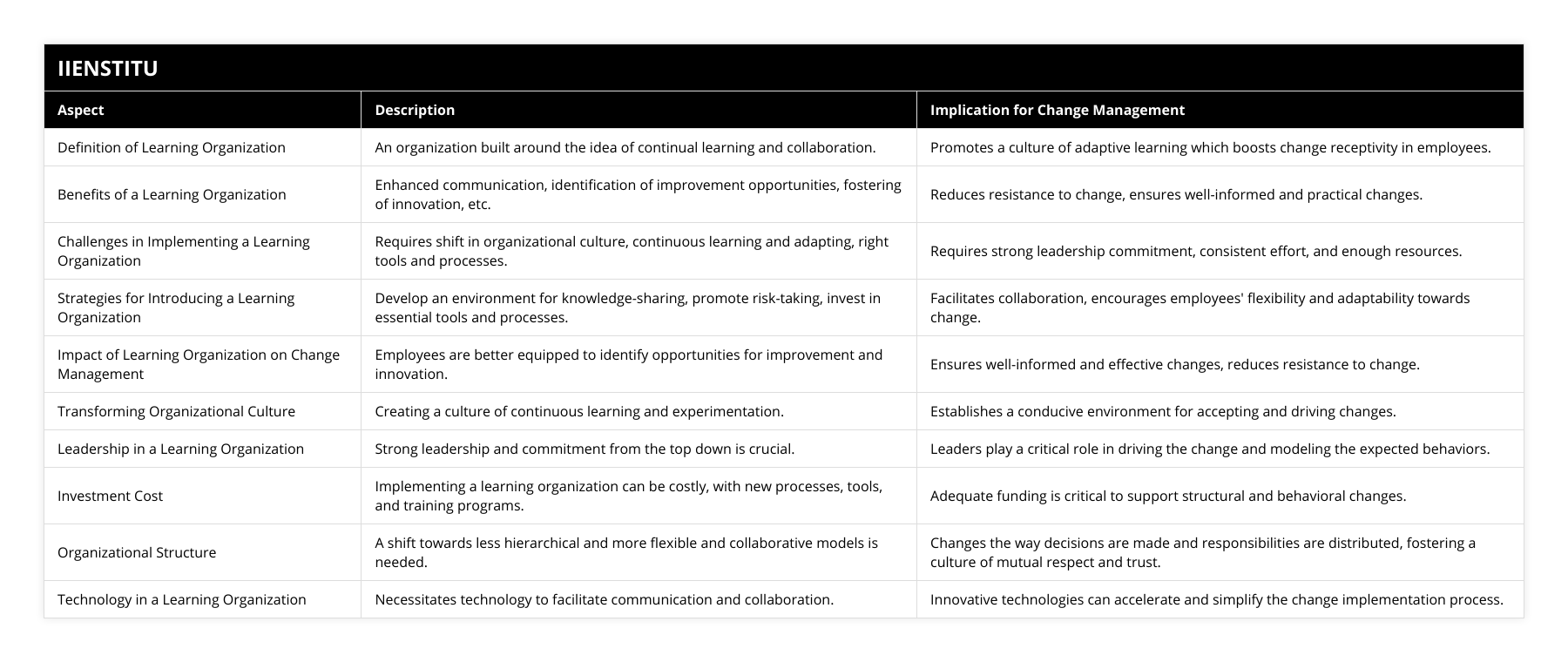
Renowned management theorist Peter Senge, in his seminal book The Fifth Discipline, emphasizes that "organizations learn only through individuals who learn." He argues that when employees at all levels engage in continuous learning, the organization as a whole becomes more adept at handling change (Senge, 1990).
The Challenges of Implementing a Learning Organization
Of course, transitioning to a learning organization isn't without its challenges. It requires a significant shift in organizational culture, which can be both time-consuming and effort-intensive. Old habits die hard, and changing mindsets is no easy feat.
One of the primary obstacles is the commitment to continuous learning and adapting. This commitment must be genuine and supported from the top down. Leadership plays a crucial role in modeling the behaviors they wish to see. If managers are resistant to change or dismissive of new ideas, it sets a tone that stifles learning.
Moreover, organizations must ensure they have the right tools and processes in place to support learning and collaboration. This might involve investing in new technologies, rethinking physical workspaces to encourage interaction, or redesigning workflows to be more inclusive.
I recall a friend who worked in a company that tried to adopt a learning culture overnight. They introduced a slew of training programs and collaboration tools, but without a clear strategy or buy-in from leadership. Employees felt overwhelmed and confused, and the initiative ultimately fizzled out. This highlights the importance of a strategic, well-planned approach when implementing such significant organizational changes.
Strategies for Successfully Introducing a Learning Organization
So how can organizations effectively introduce a learning culture? Here are some strategies that I've found to be effective:
1- Establish a Clear Vision: It's essential to have a well-defined vision of what a learning organization looks like for your context. This vision should be communicated clearly to all members, creating a shared understanding and aligning efforts towards common goals.
2- Foster Collaboration: Encourage a collaborative working environment where knowledge sharing is the norm. This can be facilitated through cross-functional teams, shared projects, and open communication channels. When employees feel comfortable working together and contributing ideas, innovation flourishes.
3- Promote Open Communication: Create an atmosphere where communication is open and honest. This involves not just sharing information but also listening actively to feedback and suggestions. It's amazing how much can be learned when everyone's voice is heard.
4- Encourage Continuous Learning: Offer opportunities for employees to learn and grow. This could be through professional development programs, workshops, or even mentorship schemes. When employees see that the organization invests in their growth, they are more motivated to contribute.
5- Reward Learning and Innovation: Recognize and reward efforts that contribute to the learning culture. This doesn't always have to be financial; sometimes, public recognition or additional responsibilities can be highly motivating.
6- Lead by Example: Leadership must embody the principles of a learning organization. When managers and executives are active learners themselves, it sets a powerful example for the rest of the team.
7- Invest in the Right Technology: Utilize technology to facilitate communication and collaboration. Tools like collaborative platforms, knowledge bases, and communication apps can break down silos and make information more accessible.
8- Be Patient and Persistent: Cultural shifts don't happen overnight. It requires patience and persistence. Celebrate small wins along the way to keep momentum going.
I remember when I was part of a team tasked with implementing a new project management system. Rather than just imposing the new tool, we involved team members in the selection process, provided training sessions, and set up a support system for questions. This participative approach made the transition smoother and increased adoption rates.
The Impact of a Learning Organization on Change Management
The positive impact of a learning organization on change management is significant. When employees are engaged learners, they are better prepared to deal with the uncertainties that come with change. They see change not as a threat but as an opportunity for growth.
A learning organization also reduces resistance to change by fostering an environment of trust and open communication. When employees are informed and involved in the change process, they are more likely to support it. This collaborative approach can lead to more effective and sustainable changes, as solutions are grounded in the collective wisdom of the organization.
Moreover, such organizations are better at identifying opportunities for improvement. They are not just reacting to change but actively shaping it. By continuously learning and adapting, they stay ahead of the curve, turning potential challenges into competitive advantages.
Embracing Systemic Coaching for Business Growth
An integral component of fostering a learning organization is the adoption of systemic coaching for business growth. Systemic coaching involves looking at the organization as a whole and understanding how different parts interact with each other. This holistic approach helps in identifying underlying issues that may not be immediately apparent.
By incorporating systemic coaching, leaders can unlock the potential of their teams, leading to increased innovation and performance. It encourages individuals to consider the broader impact of their actions and decisions, fostering a sense of ownership and responsibility.
I've witnessed firsthand how systemic coaching transformed a stagnant team into a dynamic, high-performing group. The coach helped us see beyond our individual roles, understand interdependencies, and leverage our collective strengths. This not only enhanced our productivity but also contributed to the overall growth of the business.
Overcoming the Challenges of Implementing a Learning Organization
While the benefits are clear, it's essential to acknowledge and address the challenges head-on. Here are some common hurdles and how to overcome them:
Time and Resource Investment
Establishing a learning organization requires significant time and resources. It's crucial to allocate sufficient budget and personnel to support training programs, new technologies, and change initiatives. Consider it an investment in the organization's future success.
Leadership Commitment
Strong leadership is imperative. Leaders must be willing to lead by example, embracing learning themselves and supporting their teams through the transition. This might involve leadership development programs to equip managers with the necessary skills.
Cultural Transformation
Changing an organization's culture isn't easy. It requires a deliberate strategy that includes communicating the benefits, engaging employees at all levels, and reinforcing desired behaviors. Establishing open forums, feedback mechanisms, and celebrating successes can aid in this transformation.
Restructuring Organizational Processes
Sometimes, existing structures can inhibit learning. Moving away from hierarchical decision-making models to more flexible and collaborative approaches might be necessary. This could involve flattening organizational structures or creating cross-functional teams.
Technological Challenges
Investing in the right technology is essential but can be daunting. It's important to choose tools that are user-friendly and meet the specific needs of your organization. Providing training and support ensures that employees can effectively utilize new technologies.
Conclusion
In today's fast-paced world, the ability to adapt and learn continuously is not just beneficial—it's essential. Learning organizations position themselves at the forefront of innovation, better equipped to manage change and seize new opportunities.
By fostering a culture that values continuous learning, collaboration, and open communication, organizations can overcome challenges and drive sustainable growth. The journey may be challenging, but the rewards are well worth the effort.
Reflecting on my own experiences, I can confidently say that embracing the principles of a learning organization has made a profound difference in the teams and organizations I've been part of. It's about empowering people, nurturing creativity, and building a resilient foundation that can weather any storm.
As the saying goes, "The only constant in life is change" (Heraclitus). By becoming learning organizations, businesses don't just adapt to change—they lead it.
References
Senge, P. M. (1990). The Fifth Discipline: The Art & Practice of The Learning Organization. Doubleday.
Argyris, C., & Schön, D. A. (1996). Organizational Learning II: Theory, Method, and Practice. Addison-Wesley.
Kotter, J. P. (1996). Leading Change. Harvard Business School Press.
Frequently Asked Questions
What are the key factors that contribute to climate change?
Key Factors Contributing to Climate Change
There are several key factors that contribute significantly to climate change. The most significant is the burning of fossil fuels such as coal, oil and natural gas. When fossil fuels are burned, they release greenhouse gases like carbon dioxide and methane into the atmosphere. These greenhouse gases trap heat from the sun, causing global temperatures to rise.
Deforestation is another major factor. Trees absorb and store carbon dioxide. When forests are cleared, that stored carbon is released. Deforestation also reduces the number of trees available to remove carbon dioxide from the air. Between 2015 and 2020, the world lost over 4 million hectares of forest per year.
Intensive livestock farming generates significant greenhouse gas emissions. Cows and sheep produce methane as part of their digestive process. Large scale cattle ranching leads to deforestation too. The livestock sector accounts for around 15% of global emissions.
Other contributors are fertilizers containing nitrogen and the burning of biomass. Overall, human activities are responsible for almost all of the increase in greenhouse gases over the last century. To mitigate climate change, we must transition from fossil fuels to renewable energy and prevent further deforestation. We must also reduce emissions from agriculture and other sources.

How does gender inequality manifest in different cultures?
Manifestations of Gender Inequality
Gender inequality refers to unequal treatment or perceptions of individuals based on their gender. This manifests in various ways across cultures. In many cultures, traditional gender roles cast women as caregivers and men as leaders. This leads to inequalities in domestic duties, employment, and positions of authority. For example, in parts of South Asia, women spend much more time on unpaid domestic work than men. In Saudi Arabia, strict laws prohibit women from traveling or working without a male guardian's permission.
Gender discrimination in education also perpetuates inequality. In Afghanistan, girls face barriers to attending school including lack of facilities, child marriage, and Taliban restrictions. Only 37% of Afghan girls complete primary education, compared to 66% of boys. This lack of education limits women's ability to participate in society.
Violence against women is another manifestation of gender inequality. Practices like female genital mutilation in parts of Africa, acid attacks in Southeast Asia, and honor killings in the Middle East target and control women. Up to 38% of murders of women worldwide are committed by intimate partners. Laws and enforcement often fail to protect women.
While many cultures have embedded gender inequalities, increased education for women and girls, activism, and legal protections are working to promote equal rights. Achieving gender equality requires changing long-held biases and practices.
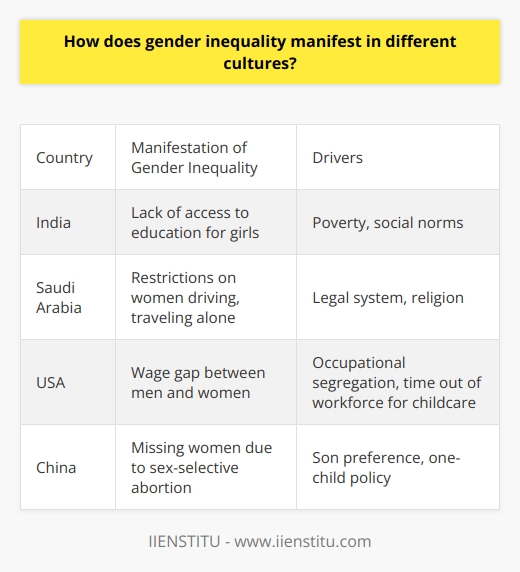
What policies can governments implement to reduce poverty?
Policies to Reduce Poverty
Governments can implement several policies to help reduce poverty. One important policy is to increase access to education. Governments can make primary and secondary education free and compulsory. They can also provide subsidies and scholarships to help low-income students attend college or vocational schools. Education gives people the skills needed to obtain better-paying jobs.
Another policy is to create more jobs and improve wages. Governments can invest in infrastructure and green technology to create construction and manufacturing jobs. They can set higher minimum wages and strengthen unions to improve pay. Policies that support small businesses can also lead to more job creation.
Governments can also strengthen social safety net programs. They can provide cash assistance, food stamps, and housing vouchers to help families meet their basic needs. Healthcare subsidies can make insurance more affordable. Increasing funding for childcare, disability, and unemployment benefits further aids those struggling financially.
Lastly, governments can reform tax policies to ease the burden on lower-income households. They can make tax systems more progressive by increasing taxes on the wealthy. Tax credits like the Earned Income Tax Credit can supplement wages for workers. Reducing regressive payroll and sales taxes helps increase take-home pay.
Implementing a mix of education, job creation, safety net, and tax reform policies can significantly reduce poverty. A comprehensive approach addresses both the symptoms and root causes of financial hardship for low-income families and individuals.

What are some effective strategies for leading organizational change?
Engaging Employees in the Change ProcessIt is crucial that leaders engage employees throughout the organizational change process. Leaders should communicate early and often about the upcoming changes, explaining the rationale and vision behind the change. They should provide opportunities for employees to ask questions and give input. When employees feel informed and included, they are more likely to support rather than resist the change. Leaders can assign employees to cross-functional teams to design and implement aspects of the change. This gives employees more control and investment in the process.
Providing Training and DevelopmentOrganizational changes often require employees to learn new skills, processes, or technology. Leaders need to assess skill gaps and provide adequate training to equip employees for their new roles and responsibilities. They may need to bring in external consultants or coaches to facilitate training sessions. Leaders should check in regularly to ensure employees are comprehending and applying the new skills. Additional support may be necessary for employees struggling with the transition. Training demonstrates the organization’s commitment to employee success.
Communicating a Compelling Vision Leaders need to articulate a clear, compelling vision for the change and how it will benefit the organization and employees. They should explain the risks of not changing versus the payoff of successful change. A powerful vision provides meaning and purpose that motivates employees to support the change. Leaders must express genuine enthusiasm and optimism when communicating their vision. This motivates others to share their positive outlook.
Providing Resources and SupportImplementing organizational change is challenging and can temporarily reduce productivity and performance. Leaders need to provide ample resources and support to smooth the transition. Employees may need additional staffing, budget, or tools to meet new expectations. Leaders should be available to listen to concerns, answer questions, and help remove obstacles. They may need to rework timelines or processes that are ineffective. Providing adequate resources and support helps sustain employee commitment during difficult transitions.
Celebrating Small WinsOrganizational change usually involves long-term initiatives that can test employee patience and endurance. Leaders should recognize and celebrate small wins along the way. Even minor successes should be publicly acknowledged and rewarded to maintain momentum. Leaders might track key milestones and hold small celebrations as each one is achieved. Recognizing incremental progress reinforces commitment to the larger vision. Employees see their efforts contributing to tangible results.
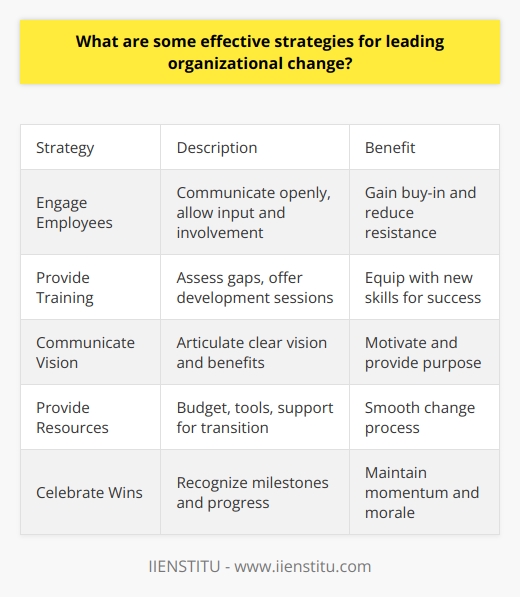
How can learning and development programs support major change initiatives in a company?
Supporting Change Through Learning and Development
Companies often undertake major change initiatives in order to adapt to evolving market conditions, new technologies, mergers and acquisitions, or other transformational events. However, major organizational change can be disruptive and unsettling for employees. Learning and development (L&D) programs can help ease the transition by equipping employees with the knowledge, skills, and mindsets needed to operate effectively in the new environment.
L&D can support change initiatives in several key ways:
Communicating the rationale for change. L&D programs like presentations, seminars, and workshops can educate employees on why the change is happening and the benefits it will bring. This builds understanding of and buy-in for the change initiative.
Developing required skills and behaviors. Change often requires employees to work in new ways. L&D provides training to develop the skills and behaviors needed for new processes, systems, job roles, etc. This ensures employees can perform effectively post-change.
Reinforcing and sustaining change. After initial training, ongoing L&D reminds employees of new expectations, provides opportunities to practice skills, and reinforces the desired cultural mindset. This helps sustain change over the long-term.
Supporting leaders and managers. People leaders play a critical role during change. Specialized L&D equips them to lead their teams through change, provide coaching and support, and model desired mindsets and behaviors.
Facilitating two-way communication. L&D programs like town halls and small group workshops provide opportunities for leaders to communicate about the change, while also allowing employees to ask questions and provide input. This two-way communication increases understanding and buy-in.
In summary, strategic use of learning and development builds employee capability, understanding, and cultural alignment to successfully implement and sustain major change initiatives. L&D provides the knowledge, skills, and platforms for communication that enable organizational change to stick.
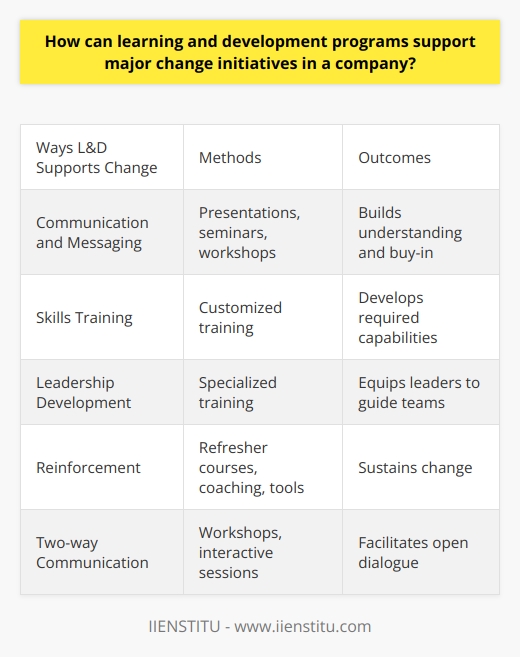
What skills are most important for change management practitioners to develop?
Interpersonal SkillsInterpersonal skills are essential for change management practitioners. They need strong communication abilities to connect with employees on an emotional level and motivate them through change. Practitioners should develop listening skills to understand employees' concerns. Empathy allows them to see change from each person's perspective. Collaboration skills help engage stakeholders in the change process. With interpersonal skills, practitioners can gain buy-in and reduce resistance.
Leadership SkillsChange leaders need leadership skills to inspire and guide organizations through transitions. They should be able to create a vision to provide direction. Leaders must make decisions to steer change efforts. Decisiveness gives people confidence. Change leaders should have integrity to build trust. With strong leadership, practitioners can motivate and influence employees to adopt changes.
Project Management Skills Project management skills enable practitioners to effectively plan and execute change initiatives. They need organization to develop detailed project plans and schedules. Resource management helps allocate people and budgets. Risk management identifies potential issues. Practitioners require planning abilities to break initiatives into manageable steps. With solid project management, they can implement changes smoothly.
Communication SkillsChange leaders need excellent communication skills to explain changes and gain buy-in. Public speaking abilities help them make persuasive presentations. Written skills allow practitioners to craft clear messages and guidelines. Active listening helps them understand employee concerns. Practitioners should tailor communications for different audiences. With strong communication skills, they can provide timely information during transitions.
AdaptabilityPractitioners require adaptability to adjust change plans based on feedback. They need flexibility to modify timelines or budgets as needs evolve. Open-mindedness allows them to consider new ideas. Change leaders must think creatively to solve problems. With adaptability, they can alter course and respond effectively when the unexpected occurs during change efforts.

What are the key differences between single-loop and double-loop learning in organizations?
Single-loop and double-loop learning are two important concepts in organizational learning theory proposed by Chris Argyris and Donald Schön. Single-loop learning involves detecting and correcting errors so that an organization can carry on its present policies or achieve its current objectives. It focuses on improving organizational effectiveness without questioning the underlying assumptions, objectives, and policies. In contrast, double-loop learning involves questioning the underlying assumptions, objectives, and policies. It leads to modification of an organization's underlying norms, policies, and objectives.
There are several key differences between single-loop and double-loop learning:
Type of Learning
Single-loop learning is adaptive learning that focuses on solving problems within the existing framework of an organization's policies, assumptions, and objectives. Double-loop learning is generative learning that questions underlying assumptions and leads to new ways of thinking and acting.
Focus
Single-loop learning focuses on effectiveness - how to achieve organizational goals and improve performance. Double-loop learning focuses on inquiry - questioning the validity of organizational norms, policies, and objectives.
Outcomes
Single-loop learning leads to minor improvements and corrections that allow the organization to carry on its present policies or achieve its current objectives. Double-loop learning leads to major changes as underlying assumptions are re-examined and transformed. This can lead to innovation in strategies, policies, objectives, and norms.
Management Orientation
Single-loop learning tends to maintain the status quo and supports management's existing frame of reference. Double-loop learning challenges the status quo as managers critically reflect on their assumptions and consider alternative perspectives.
In summary, single-loop learning focuses on improving organizational effectiveness by detecting and correcting errors within the existing system. Double-loop learning leads to innovation by questioning underlying assumptions and challenging the status quo. Single-loop learning is more tactical while double-loop learning is more strategic and transformational.
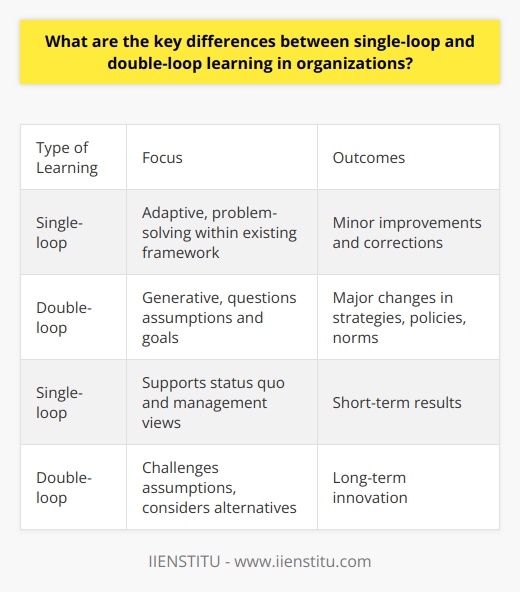
How can leaders foster a culture of learning and adaptation in times of change?
Encouraging Open CommunicationLeaders can encourage open communication during times of change to foster adaptation and learning. They should create opportunities for employees to ask questions, share concerns, and give feedback. Leaders who maintain open dialogue enable a two-way flow of information that builds understanding of the changes. They also model transparent communication themselves by explaining decisions and being receptive to input. Frequent updates through meetings, emails, and informal conversations are key.
Providing Training and DevelopmentLeaders should provide training and development programs to equip employees with the skills to adapt to changes. Workshops, seminars, and online courses help employees learn new processes, technologies, and responsibilities. Coaching and mentoring give personalized support. Rotation programs build cross-functional experience. Leaders should assess training needs, offer opportunities aligned with changes, and allow time for learning. This investment in human capital empowers adaptation.
Promoting Team Learning Leaders can promote team learning to foster adaptation. They can create cross-functional teams to tackle changes, encouraging knowledge sharing across disciplines. Leaders should allow time for teams to assess changes, brainstorm solutions, and develop recommendations. Scheduling regular team meetings and using collaboration tools facilitate this. Shared learning builds synergies that equip teams to adapt. Leaders should reward team successes to reinforce group learning.
Empowering ExperimentationLeaders can empower employees to experiment with solutions during changes. They can designate test groups to pilot new processes before organization-wide implementation. Leaders should encourage informed risk-taking and provide resources to test ideas. While celebrating successes, they should also discuss lessons from failures. This iterative approach allows for adaptation through experience. Leaders should give employees autonomy to experiment within defined parameters.
Modeling Adaptability Importantly, leaders should model adaptability themselves during times of change. They should demonstrate openness to new ideas and willingness to modify plans as conditions evolve. Leaders should discuss their own missteps and lessons learned when championing changes. Modeling agility and humility builds an adaptive culture. Employees emulate leaders who can pivot strategies while remaining aligned to values and goals. Authentic flexibility inspires organizational learning and growth.

What processes and systems can support organizational learning and knowledge management?
Organizational learning and knowledge management can be supported through several key processes and systems. Effective knowledge management requires capturing knowledge, storing it in accessible repositories, disseminating it across the organization, and applying it to make better decisions and improve performance. Some important processes for managing knowledge include identifying critical knowledge, collecting it systematically, organizing and storing it logically, and sharing it through formal and informal networks. Key systems that enable knowledge management are knowledge repositories like databases, shared drives, and portals that store explicit knowledge assets, expertise directories that map internal talent, and communication systems like email and messaging that facilitate knowledge flows.
A learning organization has a culture that promotes continuous learning and knowledge sharing. This requires leadership commitment to learning, incentives that reward learning behaviors, and a climate of psychological safety and trust. Formal learning processes like training programs, mentoring, and after-action reviews institutionalize organizational learning. Systems like learning management systems, lessons learned libraries, and online communities of practice also capture learning and make knowledge accessible. Ultimately, the organization’s structure should allow flexibility, collaboration, and bottom-up innovation to fully leverage its knowledge assets.
Some best practices for managing organizational knowledge include mapping knowledge domains, assets, experts, and flows to identify gaps, using technology like databases and portals to codify and share knowledge, creating expert networks for peer learning, and instituting governance to manage content. A knowledge-sharing culture should be cultivated through clear expectations, incentives, and leading by example. Learning can be enhanced through training programs, mentoring, staff rotations, and post-action reviews. Lessons learned need to be captured and integrated back into work practices and processes.
In summary, organizational learning and knowledge management require dedicated processes to identify, capture, organize, share, and apply knowledge. Both a supportive culture and relevant systems are needed to ingrain continuous learning and leverage institutional knowledge. This ultimately builds an intelligent organization that can quickly adapt and make informed decisions based on past lessons and collective knowledge.
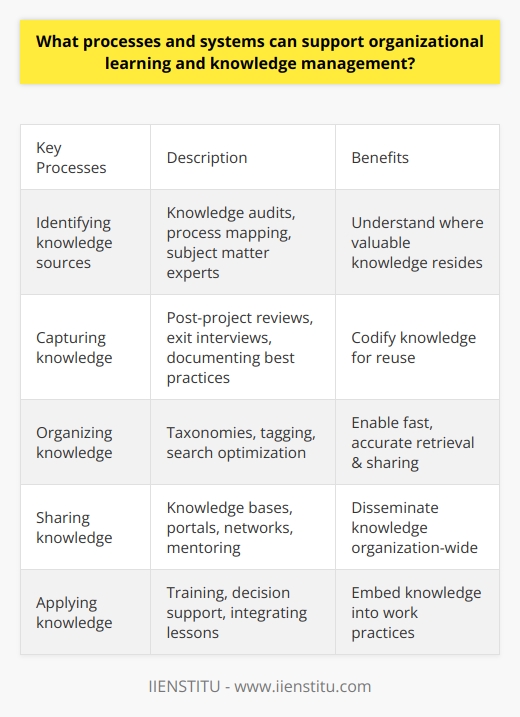
How can we facilitate learning through change in our organizations?
Embracing Change and Learning
Organizations must be willing to embrace change in order to facilitate learning. Change often brings new information, perspectives, and opportunities that can enrich organizational knowledge. However, change can also be met with resistance. To facilitate learning through change, organizations must create a culture that is open and receptive to change. Leaders should communicate the benefits of change, provide training and support during transitions, and reward adaptability. Additionally, organizations can leverage change as a learning opportunity by reflecting on successes and failures, assessing knowledge gaps that are revealed, and modifying processes to institutionalize new best practices. With an adaptive mindset oriented toward growth, organizations can utilize change to drive continuous learning and improvement.
Experimentation and Innovation
Organizations should encourage experimentation and innovation to spark learning through change. By pursuing new ideas and taking measured risks, employees can expand their skills and knowledge. Leaders should foster a psychologically safe environment where people feel comfortable trying new approaches and learning from mistakes. Resources should be dedicated to pilots, prototypes, and other experimental initiatives that test new concepts and fuel innovation. Moreover, processes like after-action reviews should be used to analyze results, share lessons learned, and integrate successful changes. An innovation-focused culture can leverage change to generate new knowledge and capabilities.
Collaboration and Idea Sharing
Cross-functional collaboration and idea sharing are key to extracting learning from change across an organization. Silos can restrict information flow and capacity building to isolated teams. However, connecting people across departments and roles builds relationships and exposes individuals to diverse ideas and skills. Shared learning resources like knowledge bases, mentoring programs, and online communities can also help spread new knowledge from change initiatives. Additionally, events like hackathons and brainstorming workshops can spark creative thinking and information exchange. By breaking down barriers and facilitating collective learning, organizations can maximize the knowledge gains from change.
Continuous Improvement Mindset
To fully leverage learning through change, organizations need a culture focused on continuous improvement. Employees at all levels should be engaged in regularly assessing processes, identifying opportunities for improvement, and implementing changes to drive progress. Leadership should provide coaching and support to empower people to recognize areas for potential growth. After changes are made, it is critical to evaluate the results, adjust as needed, and share findings across the organization. With an organizational mindset oriented toward ongoing learning and improvement through change, each iteration and innovation builds collective knowledge over time.
What strategies help employees adapt to learning through change?
Supporting Employees Through Organizational Change
Organizational change inevitably creates uncertainty and anxiety for employees. Leaders can support employees through periods of transition by clearly communicating the reasons for change, providing training and resources, and encouraging employee participation.
Leaders should explain the rationale behind organizational changes. Sharing information about external factors driving change, such as new technologies or market conditions, helps employees understand why change is necessary. Leaders should also explain how proposed changes will benefit the organization and employees. Clear communication builds trust and prevents rumors or misinformation.
Training equips employees with the skills needed to adapt to new processes, systems or job roles. Change often requires employees to update their knowledge and learn new competencies. Training sessions, manuals and online resources can provide the information and guidance employees need to successfully transition. Coaching and mentoring also promotes learning during change.
Encouraging participation gives employees a voice in the change process. Leaders can solicit employee input through surveys, focus groups or advisory committees. When employees participate in shaping changes, they feel more invested in making the change successful. Participation also allows leaders to identify potential problems or resistance early.
Organizational change brings uncertainty, but effective leadership can ease the transition. Clear communication, training and participation empower employees to embrace change. With the right strategies, leaders can guide their organization through periods of change while maintaining employee engagement and productivity.
In what ways can leaders foster a culture of learning through change?
Fostering a Culture of Learning Through Change
Leaders can foster a culture of learning in times of change in several key ways. First, they can communicate openly and frequently about the reasons for the change. Explaining the rationale behind organizational changes helps employees understand why adjustments are needed. Leaders should provide regular updates on progress and invite feedback through surveys, focus groups or town hall meetings. This transparency and inclusion makes employees feel part of the change process rather than passive recipients.
Second, leaders can provide training and professional development opportunities related to the change. For example, if new technology is being implemented, leaders can offer training sessions and bring in experts to help employees learn the new systems. Coaching and mentoring can also be invaluable in equipping employees with the skills needed to adapt to change. Investing in learning demonstrates that employees' growth and success matter.
Third, leaders can reward learning, creativity and innovation. They can recognize employees who take the initiative to develop new knowledge and skills related to organizational changes. Rewards like bonuses, recognition at company meetings, and opportunities to take on special projects can motivate continuous learning. Leaders should also encourage experimentation and celebrate intelligent failures that reflect efforts to innovate. This shows that learning matters more than perfection.
Finally, leaders should role model openness to learning and personal growth. By admitting when they need to acquire new competencies, seeking input from various sources, and discussing lessons learned from mistakes, leaders set an example. Their humility and transparency encourages employees to adopt a growth mindset rather than fearing change. Ultimately, an organization's capacity to learn determines its resilience. Leaders who foster a culture that embraces change as an opportunity for collective learning give their organization a competitive advantage.
